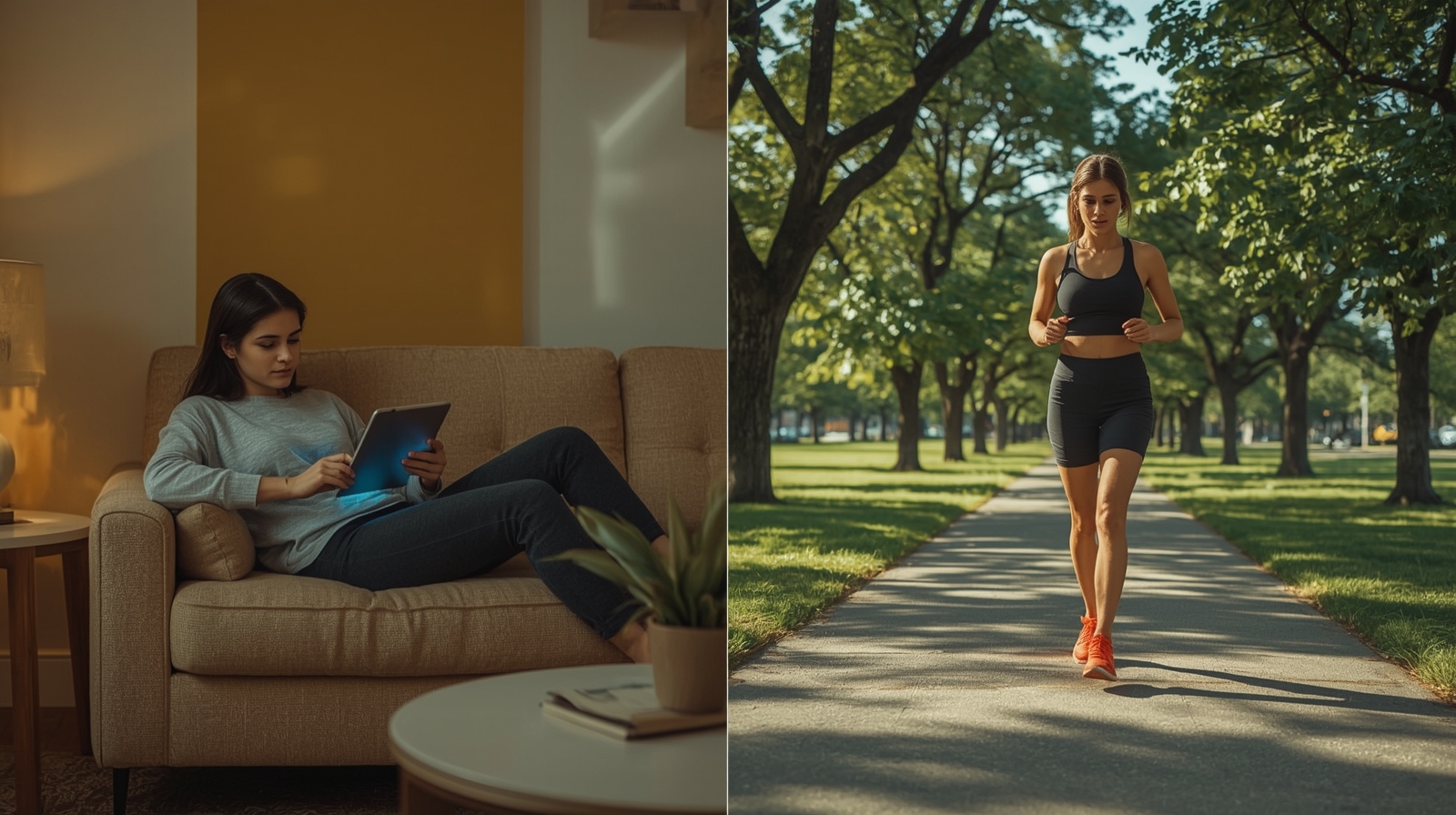Screens are everywhere. We use smartphones, laptops, and tablets to work, learn, stay connected, and relax. But without realizing it, many of us spend far more time in front of screens than we intend. According to a recent report, the average person spends 6 hours and 38 minutes a day on internet-connected screens, adding up to a staggering 5 billion days each year. Even children are developing habits around screen use, whether it’s watching videos, playing games, or endlessly swiping.
But why is it so hard to put our devices down? And what effect is all this screen time having on our health, relationships, and productivity? In this blog, we’ll explore why screens are so addictive, what makes breaking the habit difficult, and most importantly, how to reduce your screen time in simple, effective ways. You’ll learn how to shift daily routines, take back control of your time, and live with more balance and intention.
Why We Are Glued to Screens
Several psychological and social factors explain why we spend so much time on our devices. To begin with, apps and social media platforms are designed to be addictive. They deliver quick rewards, such as likes, comments, and new content, that trigger a dopamine rush, the brain’s “feel-good” chemical linked to pleasure and satisfaction. Each interaction, whether it’s a new message or someone liking your post, offers a small reward that encourages you to come back for more. Many apps use unpredictable rewards, similar to how slot machines work, making it even harder to stop scrolling or checking in.
Another strong motivator is the fear of missing out (FOMO) on news, events, or social interactions, which drives us to check notifications constantly. Furthermore, much of our daily life has shifted online. Work, school, communication, and entertainment now revolve around screens. Many jobs require video calls and constant online presence, while staying in touch with loved ones often happens through FaceTime or social platforms.
Even boredom or downtime can lead us to pick up our phones, simply because they’re always within reach. And with the convenience of 24/7 access to streaming, games, and apps, screens become the solution for almost every need or emotion. These combined psychological triggers and lifestyle shifts make it incredibly easy to fall into tech habits and much harder to break them.
How to Break the Habit
Track your screen use
The first step is awareness. Most smartphones have built-in screen time trackers like Screen Time on iPhones or Digital Wellbeing on Android that show how many hours you spend on each app. You can also use third-party apps for more detailed insights. Just seeing your daily screen time and which apps take up the most hours can be a real revelation and a great motivator to make changes.
Set clear limits and tech boundaries
Use your device’s settings to enforce limits: Set daily timers on social media or games, or turn on a “focus” or “downtime” mode that blocks apps after a certain hour. Try grayscale mode in your phone; switching the screen to gray makes it less appealing, helping you put it down more easily.
Create phone-free zones and times
Designate certain places like the bedroom or dining table, and times like meals or right before bed, as screen-free. For instance, leave your phone in another room during dinner or work without devices on the desk. A good tip is to set up a charging station outside the bedroom, so the phone isn’t by your bed at night. This not only keeps you from scrolling late at night, but also encourages a better sleep routine.
Remove distractions
Turn off non-essential notifications or put your phone on Do Not Disturb. You could also log out of social apps or even delete them temporarily if needed. Every removed pop-up is one less cue to check your screen.
Do a mini “digital detox”
Pick a short period, a few hours a day, or a whole weekend to go offline or limit screens drastically. Use that time for offline hobbies or outings. A brief detox can reset your cravings. Even a one-day break can reduce stress and improve life satisfaction, sleep, and mood. You can start by enjoying quality time with family, a no-phone picnic in the park or a game night.
Pair unplugged time with something you enjoy
Make screen breaks a choice, not a chore. Schedule screen-free periods alongside fun or relaxing alternatives. For example, after work finishes your computer and then read a chapter of a book, play guitar, or call a friend. Pairing offline time with a pleasant activity makes the break feel rewarding.
Benefits of Less Screen Time
When you cut back on screens, you’ll likely notice improvements in health and happiness. Here are some key benefits you can experience:
Better sleep
The blue light emitted by screens tricks your body into staying awake by suppressing melatonin. By turning off screens at least an hour before bed, your body can produce the sleep hormone normally. This helps you fall asleep faster and improves sleep quality.
Lower stress and improved mood
Constant screen use and social media scrolling can raise the stress hormone cortisol and lead to anxiety. Taking breaks helps balance these chemicals. Clinicians report that stepping away from screens often brings a more stable mood, with “less anxiety and depression” and even greater empathy toward others. You may simply feel calmer, less hurried, and more present in everyday life.
Better focus and mental clarity
The internet provides instant, low-effort rewards likes, quick videos, which over time can shorten attention span and make deep focus harder. Cutting back lets your brain “slow down and focus on tasks without distraction,” strengthening your concentration and self-control. Many people find they can think more clearly, be more patient, and handle tasks more effectively after reducing their screen clutter.
More physical activity
Every hour you subtract from screen time is an hour available for moving your body. High screen use correlates with sitting too much, weight gain and chronic risks like diabetes and heart disease. By swapping screen time for walks, sports or exercises, you boost your overall fitness. Even small changes can lower health risks and strengthen muscles and joints.
Healthier eyes and body
Staring at screens all day causes digital eye strain, headaches, dry eyes and neck/back pain. Looking away and blinking naturally during screen breaks relieves eye muscles and prevents strain. Reducing screen-bound posture also improves spinal health. Less time hunched over devices means your neck and back can relax and straighten, reducing the chances of chronic pain.
Richer social life
An important but often overlooked benefit is a better connection with people around you. When you look up from your phone, you’ll likely spend more quality face-to-face time with family and friends. With good screen limits, people often “engage more fully in their relationships.” By being more present, you can deepen real-world bonds that screens can inadvertently weaken.
Ideas to Get Active Instead
Free time without screens is a chance to move, explore and have fun. Here are some friendly ideas to get you up and active:
Take a walk or bike ride
It could be a stroll around the block, a hike in a local park, or just a few laps around the neighborhood. Fresh air and nature are great for stress relief, and even a short walk increases blood flow. Research suggests that simple “stroll breaks” throughout the day are an effective way to get your blood flowing and reset your mind
Play sports or games
Grab friends or family and play a pickup game of basketball, soccer, tennis, frisbee or any sport you enjoy. Not into team sports? Try swimming laps, cycling, roller-skating or even jumping rope. The goal is to have fun while moving, whether it’s shooting hoops in the driveway or swimming in a pool.
Dance to your favorite tunes
Turn up the music and dance around your living room; it doesn’t have to be a dance studio routine, just move your body however feels good. Dancing is a joyful exercise and a great mood booster. Even dancing for a few minutes to a happy song can shake off tension.
Stretch or do yoga
A short yoga or stretch routine can invigorate you and loosen up tight muscles. There are many free online videos or apps that you could even watch once, then follow without the screen. Even 5–10 minutes of mindful stretching or basic yoga poses can reduce stress and make you feel more alert.
Gardening or yard work
Tend to plants, flowers, or vegetables in a garden. Digging, planting, weeding, and watering are surprisingly good exercise, and connecting with nature has its own rewards. If you don’t have a yard, even caring for indoor plants or starting a small herb garden on a balcony counts. Gardening is “a peaceful activity that keeps you active and connected to nature”.
Additional Note
For more simple, realistic lifestyle tips and wellness ideas, explore other blogs at Elevenote – where better living begins with better choices.



